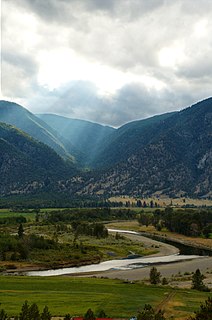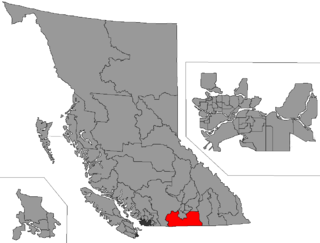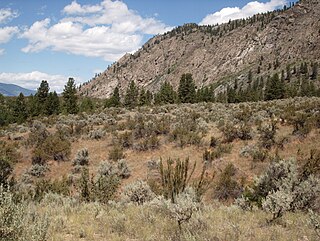| School District 53 Okanagan Similkameen | |
|---|---|
| Location | |
| Canada | |
| District information | |
| Superintendent | Beverly Young |
| Schools | 10 |
| Budget | CA$22.3 million |
| Students and staff | |
| Students | 2,665 |
| Other information | |
| Website | www |
School District 53 Okanagan Similkameen is a school district that serves fragments of the southern Okanagan and lower Similkameen regions, which include Cawston, Hedley, Keremeos, Okanagan Falls, Oliver, and Osoyoos, totaling to six communities in the district, all of which are in British Columbia, Canada. Its main "maintenance department" office is held in Oliver, consisting of ten schools, five of which are elementary, three are high or secondary schools, while two are alternative schools. This district's superintendent is Beverly Young, while 2,665 students attend schools in it; there are 480 employees for the Okanagan Simlkammen school district. Their motto is "Learning Today for Living Tomorrow", and all places within the district are towns or villages.
In addition to the conventional school programs, School District 53 offers three adult learning outlets, an outreach school, three early learning centres, as well as one elementary hockey academy; the district supports Aboriginal people. It provides a school bus transportation service, in order for children to get to their school and home, being responsible to the Director of Facilities. This bus service has been considered for expansion. School District 53 maintains a policy on emergency, which was amended on April 30, 2008. There is also a "smoke-free" policy that was amended on September 26, 2007.
School District 53 Okanagan Similkameen consists of ten schools, five of which are elementary, three are high or secondary schools, while two are alternative schools, [1] within a total of six communities in British Columbia, Canada, in fragments of the southern Okanagan and lower Similkameen regions. [2] The schools of the latter region include Cawston Primary School—held in the town of Cawston—whose principal is Shannon Miller. Cawston School is a Kindergarten to Grade 4 school that is well known for its Weekend Western Day Assembly, held on Victoria Day Weekend and featuring hobby horse barrel racing. [3] The village of Keremeos is home to Similkameen Elementary Secondary School (S.E.S.S.), which holds students from Grades 5 to 12, with the principal being Naren Searcy. [4] [5] Hedley did have a Kindergarten to Grade 4 school of its own until January 2008, when the Okanagan Similkameen district voted four to two to close the school. [6] [7] Linda Thiel was the last principal of Hedley Elementary School and oversaw its closure. [8]
In addition to the schools of the lower Similkameen, the southern Okanagan holds seven of the ten schools part of the district, [4] as well as its main "maintenance department" office, which is held in the town of Oliver. [9] All schools in the district which are part of the Okanagan region maintain the same format: elementary schools have children from Kindergarten to Grade 8, while secondary schools consist of pupils from Grade 8 to 12. This includes Okanagan Falls Elementary School, which is held in the Okanagan Falls town, with Lisa McCall serving as the school's principal. [10]
The Osoyoos town is home to Osoyoos Elementary School—whose principal is Dave Foster [11] —and Osoyoos Secondary School, which is principled by Glen Heinrichs. [12] Since 2001, British Columbia has invested over 4.8 Canadian million dollars on replacing Osoyoos Elementary School, as well as Okanagan Falls Elementary School. [7] It offers the Okanagan Similkameen Learning Centre, which consists of students from Grades 8 to 12; the principal of the learning centre is B. Hansen. [4] [13] Its neighboring town, Oliver, is home to, as of September 2011, Oliver Elementary School and Tuc-el-Nuit Elementary School—the former's principal is Mike Safek, while the latter's is Dave Foster. [14] [15]
The community also had a secondary school, named Southern Okanagan Secondary School, [4] until it was burnt by a fire in September 2011, during the school's multimillion-dollar renovation project. [16] The Royal Canadian Mounted Police's (RCMP) investigation found no conclusion. [16] The Government of British Columbia are contributing to the school's rebuilding; [16] its construction began in spring 2012, being slated for completion in 2013. [17]
In addition to the conventional school programs, School District 53 offers three adult learning outlets, an outreach school, three early learning centres, as well as one elementary hockey academy. [1] It also works with a number of Aboriginal people, having signed an enhancement agreement to improve academic achievement of them. [1] 2,665 students attend schools in this district, [1] whose superintendent is Beverley Young. [7]
1,303 of those 2,665 students within the district attend elementary schools, while 1,202 attend secondary schools; 102 are adult education students. [7] School District 53 contains 480 employees, and its motto is "Learning Today for Living Tomorrow". [1] While its board chair is Marieze Tarr, its secretary treasurer is Lynda Minnabarriet and its MLA is John Slater. [7] The district has five trustees. [7] It provides a school bus transportation service, in order to get children to their school and home, being responsible to the Director of Facilities. [18] The bus service has been considered for expansion. [19]
The British Columbia province gives funds to the school district, so that it can maintain their schools correctly. [7] The amount given is based on the number of kids that are enrolled for the year. [7] Further money is often left over by the end of the year. [7] StrongStart BC, an "early learning initiatives" program, operates at three schools within the district, Okanagan Falls Elementary School, Oliver Elementary School, Cawston Primary School, and Osoyoos Elementary School. [7] The district's boundaries include three First Nations Bands: the Osoyoos Indian Band and the upper and lower Similkameen Bands, all of which are Indian governments. [20]
An emergency—a "sudden", "unexpected" occurrence that requires action for a situation—at schools within the district 53 scope can result in school or bus transportation facilities. [21] This district's policy on emergency was amended on April 30, 2008, which includes fire, threats or facilities, violence, school bus accident, serve weather, earthquake, hazardous spills, accidents, explosions, or floods. [21] The policy was amended because the district recognizes the importance of emergencies, specifically during school's session, that could be both natural and human, hence why it necessitates to develop plans for emergencies. [21] It also maintains a "smoke-free" policy, meaning that it is prohibited to smoke in a district 53 area. [22] This rule was amended on September 26, 2007. [22]

The Okanagan, also known as the Okanagan Valley and sometimes as the Okanagan Country, is a region in the Canadian province of British Columbia defined by the basin of Okanagan Lake and the Canadian portion of the Okanagan River. It is part of the Okanagan Country, extending into the United States as Okanogan County in north-central Washington. According to the 2016 Canadian census, the region's population is 362,258. The largest populated cities are Kelowna, Penticton, Vernon and West Kelowna.
Highway 3A is the designation of two segments of highway in the southern part of British Columbia.

Osoyoos is the southernmost town in the Okanagan Valley in British Columbia between Penticton and Omak. The town is 3.6 kilometres (2.2 mi) north of the United States border with Washington state and is adjacent to the Osoyoos Indian Reserve. The origin of the name Osoyoos was the word sẁiẁs meaning "narrowing of the waters" in the local Okanagan language (Syilx'tsn). The "O-" prefix is not indigenous in origin and was attached by settler-promoters wanting to harmonize the name with other place names beginning with O in the Okanagan region. There is one local newspaper, the Osoyoos Times.

Oliver is a town near the south end of the Okanagan Valley in the Southern Interior of British Columbia, Canada, with a population of nearly 5,000 people. It is located along the Okanagan River by Tuc-el-nuit Lake between Osoyoos and Okanagan Falls, and is labeled as the Wine Capital of Canada by Tourism British Columbia. It was once "The Home of the Cantaloupe" as well as the "Home of the International Horseshow."

British Columbia Southern Interior was a federal electoral district in the province of British Columbia, Canada, that had been represented in the House of Commons of Canada from 1997 to 2015.

Princeton is a town in the Similkameen region of southern British Columbia, Canada. It lies just east of the Cascade Mountains, which continue south into Washington, Oregon and California. The Tulameen and Similkameen Rivers converge here. At the 2016 census, the population was 2,828.

The Similkameen River runs through southern British Columbia, Canada, eventually discharging into the Okanagan River near Oroville, Washington, in the United States. Through the Okanagan River, it drains to the Columbia River. The river is said to be named for an indigenous people called Similkameigh, meaning "treacherous waters".

Boundary-Similkameen is a provincial riding formed in 2008. It includes the populations of Penticton-Okanagan Valley, West Kootenay-Boundary and Yale-Lillooet. The riding's name corresponds to that of a former riding in the same area, with similar but not identical boundaries.
Okanagan-Boundary was a provincial electoral district in the Canadian province of British Columbia spanning the area from the Similkameen towns of Kaleden and Keremeos to Grand Forks and Christina Lake, and including the southern Okanagan towns of Okanagan Falls, Oliver, Osoyoos, Rock Creek and Greenwood. The riding first appeared in the 1991 election as the result of a redistribution of the former riding of Boundary-Similkameen. The same area is now part of West Kootenay-Boundary.

Keremeos is a village in the Southern Interior of British Columbia, Canada. The name originated from the Similkameen dialect of the Okanagan language word "Keremeyeus" meaning "creek which cuts its way through the flats" referring to Keremeos Creek which flows down from the Upper Benchlands to the Similkameen River that runs by the village.

The Regional District of Okanagan-Similkameen (RDOS) is in southern British Columbia, adjacent to the U.S. state of Washington. It is bounded by Fraser Valley Regional District to the west, Thompson-Nicola Regional District and Regional District of Central Okanagan to the north, Regional District of Kootenay Boundary to the east, and by Okanogan County, Washington to the south. At the 2011 census the population was 80,742. The district covers a land area of 10,413.44 square kilometres (4,020.65 sq mi). The administrative offices are in the City of Penticton.

Cawston is an unincorporated small community in the south Similkameen Valley, with a 2005 population of 973.

Osoyoos Secondary is a public high school in Osoyoos, British Columbia that is part of School District 53 Okanagan Similkameen.
The Similkameen Country, also referred to as the Similkameen Valley or Similkameen District, but generally referred to simply as The Similkameen or more archaically, Similkameen, is a region roughly coinciding with the basin of the river of the same name in the Southern Interior of British Columbia. The term "Similkameen District" also refers to the Similkameen Mining District, a defunct government administrative district, which geographically encompasses the same area, and in more casual terms may also refer to the Similkameen electoral district, which was combined with the Grand Forks-Greenwood riding by the time of the 1966 election. The Similkameen Country has deep historical connections to the Boundary Country and the two are sometimes considered one region, partly as a result of the name of the electoral district. It is also sometimes classed as being part of the Okanagan region, which results from shared regional district and other administrative boundaries and names. The term "Similkameen District" may also historically refer to the Similkameen Division Yale Land District, which also includes Osoyoos and the Boundary Country to Osoyoos' east.

The Okanagan Country, also known as the Okanagan Valley, is a region located in the Canadian province of British Columbia and the U.S. state of Washington, defined by the basin of Okanagan Lake and the Okanagan River. With an estimated 400,000 residents, the Okanagan Country spans from the Thompson Plateau near Grindrod, British Columbia in the Okanagan to the Okanagan Highland near Douglas County, Washington in the Okanogan. The largest city in the Canadian portion is Kelowna, with a metropolitan population of 194,882 residents as of 2016, while the largest city in the American portion is Omak, with 4,881 residents as of 2011. The region took its current name in honor of the Okanagan term, ukʷnaqín. The mild climate and close proximity to lakes, rivers and mountainous regions make the Okanagan Country an outdoor recreational destination. The region's economy is dominated by the primary sector industries of agriculture and forestry, although economic diversification has also occurred with retirement communities and recreational tourism. The American portion is considered to be more remote than the Canadian division, with approximately 10 percent of the population.

Dan Albas is a Canadian politician, who was elected to the House of Commons of Canada in the 2011 election. He represents the electoral district of Central Okanagan—Similkameen—Nicola as a member of the Conservative Party. In the 41st Canadian Parliament, Albas was appointed to the Standing Committee on Transport, Infrastructure and Communities and introduced one piece of legislation, a private members bill called An Act to amend the Importation of Intoxicating Liquors Act which would allow individuals to import wine from another province for the purpose of personal consumption.
The Okanagan Regional Library (ORL) system serves the Okanagan region of the Canadian province of British Columbia. Its administrative headquarters are in Kelowna. The system covers 59,000 square kilometers of area, and serves 360,000 people through 29 branches. ORL was founded in 1936. In 2013, the library held 3.2 million physical items. The library is largely funded through tax revenues from four administrative areas, the Regional District of North Okanagan, the Regional District of Central Okanagan, the Columbia-Shuswap Regional District, and the Regional District of Okanagan Similkameen. It also receives funding from the provincial and federal governments.
Similkameen Elementary Secondary School is a part of School District 53 in the Similkameen Okanagan Valley. This school is a combined high school and elementary school, with about 300 students enrolled from grade five to twelve. Staff number approximately 40. Students attending this school are primarily from the surrounding towns of Keremeos, Cawston, Hedley, and Olalla.

Tuc-el-nuit Lake is a lake in the Similkameen Division Yale Land District within the Southern Interior of British Columbia, Canada.

South Okanagan—Similkameen National Park Reserve is a proposed national park reserve located in the Regional District of Okanagan-Similkameen of British Columbia. The goal of the park is to work with the local First Nations to protect a large patch of Okanagan dry forests and part of the northern reach of the Columbia Plateau ecoregion in Canada.